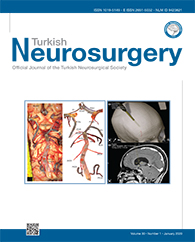2First Clinical Medical School, Nanfang Hospital, Southern Medical University, Guangzhou, China
3Basic Medical College, Navy Medical University, No.168 Changhai Road, Shanghai, China
4Department of Neurosurgery, Nanfang Hospital, Southern Medical University, Guangzhou, China DOI : 10.5137/1019-5149.JTN.26131-19.2 AIM: To predict the overall survival (OS) and the cancer-specific survival (CSS) of patients with high-grade glioma (HGG) using nomograms and the surveillance, epidemiology, and end results (SEER) database (2000-2013).
MATERIAL and METHODS: A total of 3706 patients with high-grade glioma were identified by the SEER database (2000-2013). Based on the relevant information of these patients, we divided the primary cohort into a training cohort (n=3336) and a validation cohort (n=370). The nomograms were constructed by the training cohort and corroborated by the validation cohort.
RESULTS: According to the multivariate analysis of the training cohort, the nomograms of OS and CSS indicated that patient age at diagnosis, laterality, radiation, and the extent of resection are significantly correlated with the survival rate. The c-indexes of the nomograms of OS and CSS of the training cohort are 0.682 [95% confidence interval (CI): 0.671-0.693] and 0.678 (95%CI: 0.666- 0.690), respectively. The calibration curve plots of 1- and 3-year OS and CSS showed that the nomogram predictions are consistent with the observed outcomes for both the training and validation cohorts.
CONCLUSION: Based on the data obtained, we established a scoring model to predict the OS and the CSS of patients with HGG. All calibration curves showed high consistency between the predicted and actual survival.
Keywords : Brain tumors, Glioma, Nomogram, Overall survival, Cancer-specific survival




